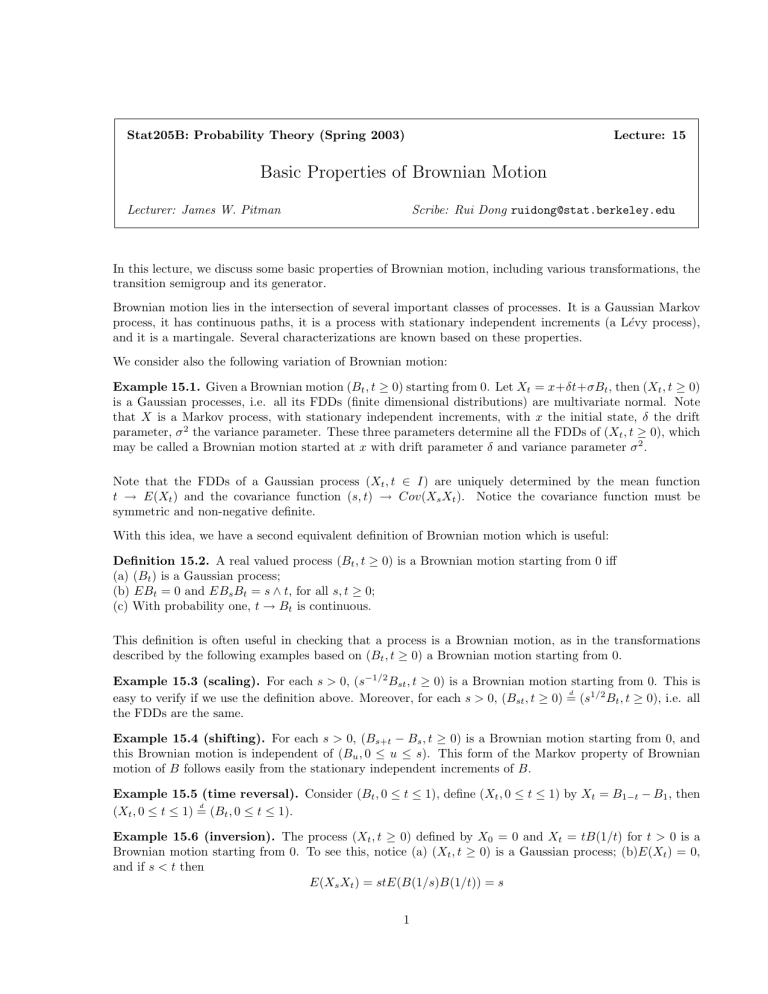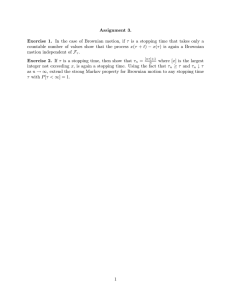
Stat205B: Probability Theory (Spring 2003)
Lecture: 15
Basic Properties of Brownian Motion
Lecturer: James W. Pitman
Scribe: Rui Dong ruidong@stat.berkeley.edu
In this lecture, we discuss some basic properties of Brownian motion, including various transformations, the
transition semigroup and its generator.
Brownian motion lies in the intersection of several important classes of processes. It is a Gaussian Markov
process, it has continuous paths, it is a process with stationary independent increments (a Lévy process),
and it is a martingale. Several characterizations are known based on these properties.
We consider also the following variation of Brownian motion:
Example 15.1. Given a Brownian motion (Bt , t ≥ 0) starting from 0. Let Xt = x+δt+σBt , then (Xt , t ≥ 0)
is a Gaussian processes, i.e. all its FDDs (finite dimensional distributions) are multivariate normal. Note
that X is a Markov process, with stationary independent increments, with x the initial state, δ the drift
parameter, σ 2 the variance parameter. These three parameters determine all the FDDs of (Xt , t ≥ 0), which
may be called a Brownian motion started at x with drift parameter δ and variance parameter σ 2 .
Note that the FDDs of a Gaussian process (Xt , t ∈ I) are uniquely determined by the mean function
t → E(Xt ) and the covariance function (s, t) → Cov(Xs Xt ). Notice the covariance function must be
symmetric and non-negative definite.
With this idea, we have a second equivalent definition of Brownian motion which is useful:
Definition 15.2. A real valued process (Bt , t ≥ 0) is a Brownian motion starting from 0 iff
(a) (Bt ) is a Gaussian process;
(b) EBt = 0 and EBs Bt = s ∧ t, for all s, t ≥ 0;
(c) With probability one, t → Bt is continuous.
This definition is often useful in checking that a process is a Brownian motion, as in the transformations
described by the following examples based on (Bt , t ≥ 0) a Brownian motion starting from 0.
Example 15.3 (scaling). For each s > 0, (s−1/2 Bst , t ≥ 0) is a Brownian motion starting from 0. This is
d
easy to verify if we use the definition above. Moreover, for each s > 0, (Bst , t ≥ 0) = (s1/2 Bt , t ≥ 0), i.e. all
the FDDs are the same.
Example 15.4 (shifting). For each s > 0, (Bs+t − Bs , t ≥ 0) is a Brownian motion starting from 0, and
this Brownian motion is independent of (Bu , 0 ≤ u ≤ s). This form of the Markov property of Brownian
motion of B follows easily from the stationary independent increments of B.
Example 15.5 (time reversal). Consider (Bt , 0 ≤ t ≤ 1), define (Xt , 0 ≤ t ≤ 1) by Xt = B1−t − B1 , then
d
(Xt , 0 ≤ t ≤ 1) = (Bt , 0 ≤ t ≤ 1).
Example 15.6 (inversion). The process (Xt , t ≥ 0) defined by X0 = 0 and Xt = tB(1/t) for t > 0 is a
Brownian motion starting from 0. To see this, notice (a) (Xt , t ≥ 0) is a Gaussian process; (b)E(Xt ) = 0,
and if s < t then
E(Xs Xt ) = stE(B(1/s)B(1/t)) = s
1
2
Basic Properties of Brownian Motion
(c)X clearly has paths that are continuous in t provided t > 0. To handle t = 0, we note X has the same FDD
on a dense set as a Brownian motion starting from 0, then recall in the previous work, the construction of
Brownian motion gives us a unique extension of such a process, which is continuous at t = 0. An alternative
method is the following:
Direct proof of continuity. By strong law of large numbers, Bn /n → 0 as n → ∞ through the integers.
To handle values between integers, use Kolmogorovs inequality,
P ( sup |B(n + k2−m ) − Bn | > n2/3 ) ≤ n−4/3 E(Bn+1 − Bn )2
0<k≤2m
Let m → ∞ we get
P(
|Bu − Bn | > n2/3 ) ≤ n−4/3
sup
u∈[n,n+1]
P
Since n n−4/3 < ∞, the Borel-Cantelli lemma implies Bu /u → 0 as u → ∞. Taking u = 1/t, we have
Xt → 0 as t → 0.
Now, let P0 be the Wiener measure i.e. the distribution of (Bt , t ≥ 0) starting from B0 = 0, and let Px be
the distribution of (x + Bt , t ≥ 0). Consider the Brownian motion as a time-homogenous Markov process
with transition kernel
1 − (y−x)2
2t
pt (x, dy) = √
e
dy
2πt
Generally, given a groupR of probability kernels {pt , t ≥ 0}, we can define the corresponding transition
operators as Pt f (x) := pt (x, dy)f (y) acting on bounded or non-negative measurable functions f . There
is an important relation between these two things:
Theorem 15.7 (semigroup property). The probability kernels {pt , t ≥ 0}, satisfy the Chapman-Kolmogrov
relation iff the corresponding transition operators {Pt } have the semigroup property
Ps+t = Ps ◦ Pt
s, t ≥ 0
Proof. For each bounded and measurable f ,
Z
Pt+s f (x) = ps+t (x, dy)f (y)
Z
Z
= ps (x, dz) pt (z, dy)f (y)
Chapman-Kolmogrov relation
Z
= ps (x, dz)Pt (f (z)) = (Ps ◦ Pt )f (x)
If {pt , t ≥ 0} is the family of transition kernels of a Markov process, the Markov property guarantees
the Chapman-Kolmogrov relation, so the family of opertators {Pt } associated with a Markov process is a
semigroup. The generator Q of the transition semigroup {Pt } is an operator defined as
Qf := lim
t↓0
Pt f − f
t
for suitable f , meaning that the limit exists in some sense.
Basic Properties of Brownian Motion
3
Now consider the semigroup of transition operators {Pt } and its generator for Browning motion. By definition,
Z
Pt f (x) =
pt (x, y)f (y)dy
R
Z
1 − (y−x)2
2t
√
e
f (y)dy
=
2πt
Z
√
z2
1
√ e− 2 f (x + tz)dz
=
2π
As for the generator, for f with two continuous derivatives f 0 and f 00 such that f 00 is bounded,
Pt f (x) − f (x)
t↓0
t
√
Z
z 2 f (x +
1
tz) − f (x)
dz
= lim √ e− 2
t↓0
t
2π
√
√
Z
0
z 2 f (x)
1
tz + f 00 (x + θ tz)tz 2 /2
= lim √ e− 2
dz
t↓0
t
2π
√
Z
1 − z2 f 00 (x + θ tz)z 2
2
dz
= lim √ e
t↓0
2
2π
1
= f 00 (x)
2
√
√
√
where θ ∈ [0, 1] is function of x and tz, so as t ↓ 0 there is the convergence θ tz → 0, hence f 00 (x+θ tz) →
f 00 (x) by continuity of f 00 , and the last step is justified by the dominated convergence theorem, using the
assumption that f 00 is bounded.
Qf (x) = lim
R. Durrett. (1996). Probability: theory and examples.(2nd Edition) Duxbury Press.
O. Kallenberg. (1997). Foundations of Modern Probability. Springer-Verlag.






